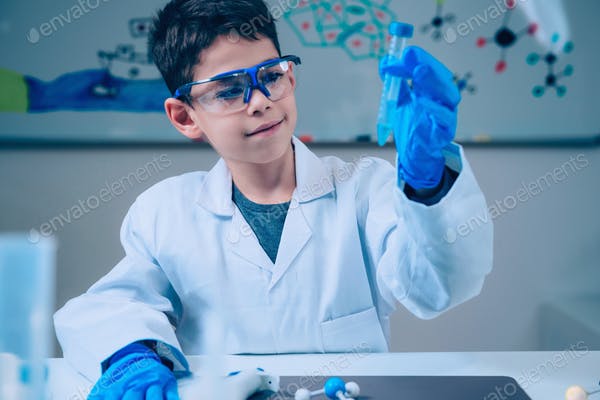Solids & Liquids & Gasses, Oh My!
Solids & Liquids & Gasses, Oh My!
- Activity Add-ons
- Activity Printables
- Activity Add-ons
- Activity Printables

Materials
- Ice cubes
- Large bowl
- Stove
- Pot or kettle
- (Optional) containers of other shapes (vases, cups, glasses, etc.)
- (Optional) Ice cube tray
Instructions
- Fill a bowl with ice. Let your child touch the ice. Talk about solids and their properties. A solid matter has a definite shape and volume that cannot easily be changed.
- Now let the ice melt, which will be the longest part of this science experiment unless you speed things along. You can point a hairdryer at the bowl or put it into a larger bowl with hot water in it. You could also go about your daily business and simply come back to the experiment later. If you choose this route, try to start the experiment in the morning to allow plenty of time for the other two parts. Talk about how water is still matter, but it is free-flowing and takes the shape of whatever container you put it in. Put the water from your bowl into different shaped containers so your child can observe this.
- Finally, pour the water into a pot or kettle and heat the water on the stove. As it begins to boil, steam will rise, which is a gas. Have them watch the condensation droplets form as it touches whatever is above your stove and cools back down. Let them get near enough to the steam to feel the warmth and extra humidity of the surrounding air. Talk about how gas still takes up space but has no shape since it goes everywhere and seems to disappear.
Solids & Liquids & Gasses, Oh My!
- Activity Add-ons
- Activity Printables
- Activity Add-ons
- Activity Printables
Make STEM Connections
Learn about science with the Berenstain Bears.
There is an excellent Berenstain Bears book that teaches several science concepts, including states of matter using water, ice, and steam. The wording is suitable for young children, so it makes a great introduction to many scientific concepts, as well as provides ideas for simple experiments.
Talk about fire safety.
Many gasses are almost invisible, making them hard to see. If you have a gas stove or candle lighter at home, what you are seeing when someone turns it on to cook is not the gas, it is the fire burning the gas up. Fire can’t burn without another kind of gas too, oxygen, the gas we all breathe! That is one of the reasons why, if there is ever a fire, you aren’t supposed to open doors because that provides the fire with more oxygen and might make the fire bigger. Try making a campfire outside or in your fireplace and see what happens when you blow or use bellows on the flames.
Make some slime.
Your slime will stretch if you pull it slowly, but it breaks if you pull it too fast, because slime is a non-Newtonian fluid. Non-Newtonian fluids like Oobleck, quicksand, and silly putty change state from solid to the liquid-based matter depending upon the pressure that is applied to them. Have your child experiment to see how it works. To make the slime:
- Pour 1/4 cup glue into a large bowl. Add one tablespoon water and stir until combined. Slowly add 1/8 cup liquid starch and mix until thick and slimy, making sure there is no unmixed glue hiding in the center of your slime.
- Knead the slime with your hands. It may be easiest to remove the slime from the bowl and use a clean, flat surface for kneading. If the slime is still too sticky, return it to the bowl and add additional starch, a little bit at a time, and knead until it’s the right consistency.